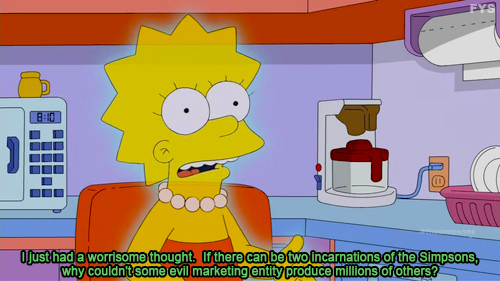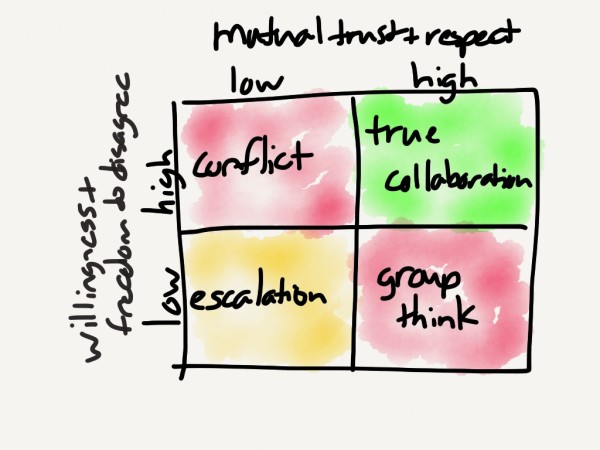
k2e4:
johnlockinthetardiswithdestiel:
whoa canada
someone needs to turn down that sass level
Two things to know about Canada!
- We are smart enough to know hot things should be hot.
- We are sorry if you don’t
fun story about the reason they do that (at least in America)
once this lady spilled her McDonald’s coffee on herself and ended up getting like 3rd degree burns and since there was no warning on the cup she was able to claim she didn’t know it would be hot (or at least that hot) and won a lawsuit against McDonald’s for $1 million
That’s what the media smear campaign against her would have you believe, anyway. The truth of the matter is that the McDonald’s in question had previously been cited - on at least two separate occasions - for keeping their coffee so hot that it violated local occupational health and safety regulations. The lady didn’t win her lawsuit because American courts are stupid; she won it because the McDonald’s she bought that coffee from was actively and knowingly breaking the law with respect to the temperature of its coffee at the time of the incident.
(I mean, do you have any idea what a third-degree burn actually is? Third-degree burns involve “full thickness” tissue damage; we’re talking bone-deep, with possible destruction of tissue. Can you even imagine how hot that cup of coffee would have to have been to inflict that kind of damage in the few seconds it was in contact with her skin?)
Yeah I’m tired of people joking about either the “stupid” woman who didn’t know coffee was hot or the “greedy” woman making up bullshit to get money.
She was hideously injured by hideous irresponsibility, it was an absolutely legitimate lawsuit and the warning on the cups basically allows McDonalds to claim no responsibility even if it happens again. Every other company followed suit to cover their asses.
So they can still legally serve you something that could sear off the end of your tongue or permanently demolish the front of your gums and just give you a big fat middle finger in court. “The label SAID it would be HOT, STUPID.”
obligatory reblog for the great debunking of the usual ignorance spouted about this case
obligatory mention that the media smear campaign to twist teh facts on this case and get public opinion against the victim was deliberate and fueled by the right wing tort reform movement
it was seized upon to limit the rights of consumers to hold giant corporations accountable for wrongdoing
watch the documentary Hot Coffee, it lays out all of the facts and examines the response to this case and explains why everything you think you know about this case is bullshit, and explains why tort reform is bullshit in an entertaining and informative manner
The woman injured in Liebeck v. McDonald’s Restaurants was 79 years old at the time of her injuries, and suffered third-degree burns to the pelvic region (including her thighs, buttocks, and groin), which in combination with lesser burns in the surrounding regions caused damage to an area totaling a whopping 22% of her body’s surface. These injuries that required two years of intensive medical care, including multiple skin grafts; during her hospitalization, Stella Liebeck lost around 20% of her starting body weight.
She was uninsured and sued McDonald’s Restaurants for the cost of her past and projected future medical care, an estimated $20,000. The corporation offered a settlement of $800, a number so obviously ridiculous that I’m not even going to dignify it with any further explanation.
The settlement number most often quoted is not the amount that the corporation actually paid; the jury in the first trial suggested a payment equal to a day or two of coffee revenues for McDonald’s, which at the time totaled more than $1 million per diem. The judge reduced the required payout to around $640,000 in both compensatory and punitive damages, and the case was later settled out of court for less than $600,000.
Keep in mind that at the time, McDonald’s already had over 700 cases of complaints about coffee-related burns on file, but continued to sell coffee heated to nearly 200 degrees Fahrenheit (around 90 degrees Celsius) as a means of boosting sales (their selling point was that one could buy the coffee, drive to a second location such as work or home, and still have a piping hot beverage). This in spite of the fact that most restaurants serve coffee between 140 and 160 degrees Fahrenheit (60 to 71 degrees Celsius), and many coffee experts agree that such high temperatures are desirable only during the brewing process itself.
The Liebeck case was absolutely not an example of litigation-happy Americans expecting corporations to cover their asses for their own stupidity, but we seem determined to remember it that way. It’s an issue of liability, and the allowable lengths of capitalism, and even of the way in which our society is incredibly dangerous for and punitive towards the uninsured, but it was not and is not a frivolous suit. Please check your assumptions and do your research before you turn a burn victim’s suffering into a throwaway punchline.
#don’t fricking get me started on Liebeck v. McDonald’s Restaurants the level of misinformation floating around is staggering#I know that it’s an older case but it still makes me really mad that people treat it as this big dumb thing?#the fact that the media took a serious case and turned it into what it is to us today should piss people off#the level of distortion of facts is astonishing and upsetting and nobody seems to hear about it?#sorry I’m done I just#it upsets me when a legal travesty like this is just dragged out for some#’haha americans are sOOOOOOOo dumb!!1!’ humor#I MEAN GODDAMN IF YOU’RE GOING TO MAKE FUN OF AMERICANS AT LEAST MAKE FUN OF US WITH FACTS OKAY
jesus, i actually didn’t know about any of this, thanks for clearing that up
So someone mentioned the documentary Hot Coffee, which I watched just last night, and I want to share some tidbits with you:
In the US, people’s right to sue has been getting steadily eroded and things like making people believe the hot coffee case were frivolous are part of it. That’s how they get people to actually vote for limitations on their own rights to sue, or for caps on damages, when in fact ‘tort reform’ laws usually end up, e.g., reducing the amount you can get in a malpractice suit.
And there’s also a lot of sneaky shit like people unknowingly signing away their right to sue in the fine print (or being told they have in a ‘supplementary package’ of fine print delivered to them AFTER they signed the contract), and ending up in ‘binding mandatory arbitration’. You’ve probably signed dozens of contracts like this, e.g., for your cellphone and credit card. You have basically ‘agreed’ that is you have any dispute for any reason you cannot sue for damages, you have to have a secret meaning with an arbitrator hired by the person / entity that harmed you to act as judge.
There was some really striking examples in the documentary. One was a kid born with severe brain damage because he wasn’t delivered properly, resulting in oxygen deprivation for about 8 minutes during birth; professional estimates for his cost of living (including numerous surgeries and physical therapy, starting at just one year old) for the rest of his life was about $6 million. The jury awarded $5.6. That’s doable, right?
Well, except in that state (Nebraska) there was an award cap of $1.25 million, which, after paying legal bills and the already accrued medical expenses, left the kid with just a few hundred thousand. So, he’s now on medicaid to pay for his therapy, surgeries, and basic living expenses. The cost of his treatment has basically been transferred to the taxpayer, and should anything happen to his parents they have no idea what would happen to him or who would take care of him.
Another was a Haliburton employee who went to Iraq as part of Operation Iraqi Freedom, Miss Jamie Leigh Jones. (Warning for the next paragraph: discussion of rape.)
Long story short: she was lied to about her accommodations and ended up housed in barrack with 400 men. She was sexually harassed and threatened. She complained about it, twice, and was told she’d ‘get over it’. She ended up being drugged and gang raped. She needed reconstructive surgery for anal and vaginal tearing. What do you think happened next?She was locked in a shipping container with two armed guards for days, until one of them, out of sympathy and in defiance of orders, let her borrow his cellphone. She called her father who called some congressman and got her out of there.
She then spent 4 years fighting for her day in court, because unbeknownst to her she’d signed a binding mandatory arbitration agreement. She was 19 when all of this happened.
So, conclusion: the myth of frivolous lawsuits is kinda like the myth of the welfare queen. There have probably been a few that occurred sometime, somewhere, sure, but I bet you’d be hard-pressed to find them. Most people who file a suit have damn good reasons, and if they don’t the suit usually gets thrown out of court by a judge before they even waste time assembling a jury.
(Oh, another bit of shady shit discussed in the movies: big businesses trying to influence judge elections, or defame / dethrone already elected judges, if it seems they’re actually in favour of the common people’s right to civil litigation. During Judge Oliver Diaz’s election, he was subject to a massive, multi-million dollar smear campaign. When he won anyway, he was subject to another smear campaign: because a friend had co-signed a loan with him, he was accused of accepting a bribe, even though he had never presided on any case having to do with this friend or his law firm. In effect, his reputation was ruined and he couldn’t get elected again. This was not an isolated incident.)Meanwhile, laws and ‘reforms’ to curb ‘litigation abuse’ do more harm than good. If you hear a politician talking about ‘lawsuit lotteries’ and a need for ‘tort reform’, think of Reagan talking about ‘welfare queens’; think about how the vast majority of people on welfare do, desperately, need it.
What we’re really looking at is people eroding our social safety net, because they’re lucky / wealthy enough to view it as inconvenient.
Dan writes:
The front end technology is not the problem here. It would be nice if it was the problem, because web page scaling issues are known problems and relatively easy to solve.
The real problems are with the back end of the software. When you try to get a quote for health insurance, the system has to connect to computers at the IRS, the VA, Medicaid/CHIP, various state agencies, Treasury, and HHS. They also have to connect to all the health plan carriers to get pre-subsidy pricing. All of these queries receive data that is then fed into the online calculator to give you a price. If any of these queries fails, the whole transaction fails.
Most of these systems are old legacy systems with their own unique data formats. Some have been around since the 1960′s, and the people who wrote the code that runs on them are long gone. If one of these old crappy systems takes too long to respond, the transaction times out.
Amazingly, none of this was tested until a week or two before the rollout, and the tests failed. They released the web site to the public anyway – an act which would border on criminal negligence if it was done in the private sector and someone was harmed. Their load tests crashed the system with only 200 simultaneous transactions – a load that even the worst-written front-end software could easily handle.
When you even contemplate bringing an old legacy system into a large-scale web project, you should do load testing on that system as part of the feasibility process before you ever write a line of production code, because if those old servers can’t handle the load, your whole project is dead in the water if you are forced to rely on them. There are no easy fixes for the fact that a 30 year old mainframe can not handle thousands of simultaneous queries. And upgrading all the back-end systems is a bigger job than the web site itself. Some of those systems are still there because attempts to upgrade them failed in the past. Too much legacy software, too many other co-reliant systems, etc. So if they aren’t going to handle the job, you need a completely different design for your public portal.
A lot of focus has been on the front-end code, because that’s the code that we can inspect, and it’s the code that lots of amateur web programmers are familiar with, so everyone’s got an opinion. And sure, it’s horribly written in many places. But in systems like this the problems that keep you up at night are almost always in the back-end integration.
The root problem was horrific management. The end result is a system built incorrectly and shipped without doing the kind of testing that sound engineering practices call for. These aren’t ‘mistakes’, they are the result of gross negligence, ignorance, and the violation of engineering best practices at just about every step of the way..
…“No way would Apple, Amazon, UPS, FedEx outsource their computer systems and software development, or their IT operations, to anyone else.”
You have to be kidding. How do you think SAP makes a living? Or Oracle? Or PeopleSoft? Or IBM, which has become little more than an IT service provider to other companies?
Everyone outsources large portions of their IT, and they should. It’s called specialization and division of labor. If FedEx’s core competence is not in IT, they should outsource their IT to people who know what they are doing.
In fact, the failure of Obamacare’s web portal can be more reasonably blamed on the government’s unwillingness to outsource the key piece of the project – the integration lead. Rather than hiring an outside integration lead and giving them responsibility for delivering on time, for some inexplicable reason the administration decided to make the Center for Medicare and Medicaid services the integration lead for a massive IT project despite the fact that CMS has no experience managing large IT projects.
Failure isn’t rare for government IT projects – it’s the norm. Over 90% of them fail to deliver on time and on budget. But more frighteningly, over 40% of them fail absolutely and are never delivered. This is because the core requirements for a successful project – solid up-front analysis and requirements, tight control over requirements changes, and clear coordination of responsibility with accountability, are all things that government tends to be very poor at,
The mystery is why we keep letting them try.
Consider this Part 2 in an accidental series on Microsoft’s recent reorganization, and functional and divisional organizations. Part 1 focused on a divisional organization, while today’s Part 2 focuses on functional ones.
The “Uncanny Value” is most typically associated with animated films (although it was originally about robots). From Wikipedia:
The uncanny valley is a hypothesis in the field of human aesthetics which holds that when human features look and move almost, but not perfectly, like natural human beings, it causes a response of revulsion among human observers. Examples can be found in the fields of robotics, 3D computer animation, and in medical fields such as burn reconstruction, infectious diseases, neurological conditions, and plastic surgery. The “valley” refers to the dip in a graph of the comfort level of humans as subjects move toward a healthy, natural human likeness described in a function of a subject’s aesthetic acceptability.
The graph looks like this:

Hypothesized emotional response of human subjects is plotted against anthropomorphism of a robot, following Mori’s statements. The uncanny valley is the region of negative emotional response towards robots that seem “almost human”. Movement amplifies the emotional response — Wikipedia
I actually think the concept can be applied to many more things than just human aesthetics: anything that is almost perfect, but not quite, is actually worse than something that is good enough:
Consider organizational design. While I am very critical of Microsoft’s decision to reorganize functionally, that does not mean I think that functional organizations are bad. Quite the contrary, in fact. I (and Apple) believe that functional organizations are an essential ingredient to producing truly great products. They are the “best.”
But the reasons functional organizations are theoretically “best” are the exact same reasons why it is so difficult to manage a functional organization. Get any of the following wrong and your organization – e.g. Microsoft – is in a far worse place than if you had settled for a “good enough” divisional structure.
Functional organizations rely on true collaboration
Collaboration is one of those buzzwords that will get you wasted in a drinking game; it’s on the lips of every innovation consultant, thought leader, and CEO. The concept – working together to make something great – seems straightforward, but the fact it’s always the proposed cure is evidence enough it’s hard to achieve.
The reason why is easier to understand when you understand what goes into true collaboration: mutual trust and respect, and the willingness and freedom to disagree.
Both ingredients are really hard for humans in groups. Start with mutual trust and respect: we’re all naturally suspicious of those we aren’t intimate with, and that’s compounded by the anxiety of status and salary inherent in a workplace. It’s even worse at top companies, where nearly every employee grew up the smartest kid in their class and can’t help but try to prove they’re still the best.
As for disagreement, it’s actually the willingness that is more challenging than the freedom. It turns out we humans usually want other people to like us. In fact, we usually want other people to like us more than we want to make something great, so we hesitate to criticize and point out flaws.
The upside should be obvious: it really is possible for the whole to be greater than the sum of the parts. As much as we glorify the solitary coder or designer, the truth is that, especially in technology, breakthroughs are collaborative and iterative, borne of thousands of disagreements. It’s one reason Apple is absolutely committed to a functional organization; there, design, software, hardware, operations, and product marketing are all separated; every decision is necessarily made collaboratively, and (theoretically) results in a better outcome.
However, a company organized functionally that does not have the necessary cultural ingredients for true collaboration is actually in worse shape for having tried; the disagreements will turn into conflict, and the agreements made through groupthink will arguably be worse.

As I noted last week, saying that Microsoft lacks “the necessary cultural ingredients for true collaboration” is an understatement.
Functional organizations rely on effective, visionary leaders
Functional organizations are unusually reliant on a visionary leader. Look again at the graphic of a functional organization:
Everything is tied together at the CEO-level, which means communication channels must be excellent, both from the bottom and up and also across functions. Moreover, the vast majority of employees only ever see a piece of the product; it’s up to the CEO to set the broad vision and ensure that it is being followed.
The upside is a holistic and integrated quality to the resultant products that is truly extraordinary. People talk about how the iPhone integrated hardware and software, but that just a crude approximation for what is effectively a single vision of what a phone should be, down to the tiniest detail.
It’s on this point, actually, that concern and criticism of Tim Cook is most warranted. I’ve already made the case as to why he is a great CEO for Apple, but his greatest weakness – product vision – is hugely magnified by the fact that Apple is organized functionally, and thus especially reliant on a visionary leader (this should, of course, make it obvious why Steve Jobs was so insistent on a functional organization). Clearly Jony Ive has been nominated to fill the role of visionary; it is likely that at least one of Ive’s once-peers was not happy about that elevation.
As for Microsoft having a visionary leader, well…
A divisional org, on the other hand, pushes communication and decision-making down into the hierarchy; this makes broad, company-wide endeavors less likely – both breakthroughs, and disasters.
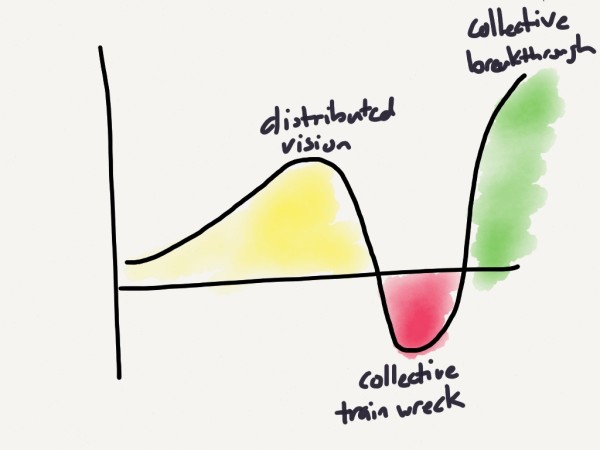
Functional organizations are focused
One of the more interesting elements of the Microsoft reorganization is that it in some ways seems inspired by former Windows President Steven Sinofsky and his thoughts on One Strategy. Sinofsky was a major proponent of functional organizations, and in fact transformed the Windows division from a divisional structure to a functional one, at least on the engineering side.
Both Windows 7 and 8 were the products of that organizational change, and bear out the idea that focus and prioritization make all the difference in the world (leaving aside the merits of the Windows 8 design, it is an engineering marvel, especially considering the timeframe within which it was built).
Still, the fact that Windows is such a massive product meant that Sinofsky himself estimated he only saw a fraction of what mattered:
I have been asked by many what it is like to be a “business leader” and I remind people that even at my job I have no say in tons of things that matter a lot to whether our work is successful (when thought of from the 4 P’s of marketing: product, price, promotion, placement I only have say in 25% of the business, at best). But we have built our team, both in terms of feature teams and in terms of engineering structure so that we can have a balance if we all operate from a shared plan.
If Sinofsky, one of the most iron-fisted executives you will ever see, only saw 25% of what mattered despite sitting at the only nexus for information flow (as noted above), what chance does Ballmer have sitting at the intersection of Windows, Office, Service, Xbox, Bing, etc.?
This is something for Apple to be concerned about, as well. Things like TVs and watches are fun to talk about, but they exact a real cost on the leadership team’s ability to manage the organization.
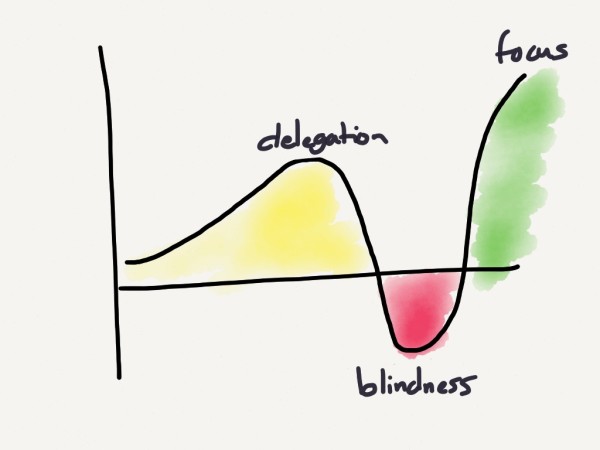
Functional organizations rely on experts
This is the necessary bookend to collaboration, one of the biggest reasons that functional organizations produce better products. If you are creating something new, would you rather its creators be the best in the world at what they do, or that they be someone trying their hand at a new role with an eye towards career advancement?
I touched on this briefly last week, but it’s worth a closer look:
- The ideal employee in a functional organization is an expert who truly loves the type of work they do. Their reward is to do more of what they do, or perhaps lead others who do the same type of work.
- The ideal employee in a divisional organization is a generalist. They may start out doing a particularly type of work as an individual contributor, but their next job is likely to be about broadening, not deepening their skills
There are thousands of employees at Microsoft building nice careers as well-rounded managers; they are all now (theoretically) superfluous, as broad management is only practiced at the CEO level in a functional organization. All these middle managers are likely to either sabotage the reorganization by clinging to their former authority, or simply leave the company. While the latter may be a theoretically good outcome, that is only the long run, in which time we are all dead. In the short run it could be a serious talent and experience drain.
The challenge for a functional organization is more subtle. The best sort of employee finds fulfillment in nothing more than the work they do; the more typical one eventually seeks greener pastures and/or burns out.

As I noted last week, all company’s start out functionally organized. After all, they only have one product.
So why do they change, especially if functional companies make better products?
Let’s follow the typical path: Company A makes an amazing product, finds a great market fit, and starts to make a lot of money. They IPO. They continue to grow, and the stock goes up. And then the stock stops going up, because it’s not clear how they will continue to grow. A stock’s worth, after all, is simply the discounted sum of future earnings.
And so the company looks for another avenue of growth. They diversify, maybe successfully, but now they have two products. And soon, like DuPont, they see the wisdom in having two divisions.
Of course, those divisions are certainly related in some way, and it’s inevitable that considerations are given – or dictated, from the CEO – that decisions in one divisions favor the other division whenever possible. This consideration is called a strategy tax, and it’s a hindrance to product quality. So is the inevitable competition for resources, and the increasingly divided attention of the CEO.
It’s all interconnected. There is a tension between product quality, growth, and the stock market. The problem for Microsoft is they have already made their choice: they are a diversified company with a clear focus on the top and bottom lines. It’s not that a functional organization is a bad thing – it’s a great thing – but Microsoft is simply no longer capable of climbing that hill.
And that leaves the uncanny valley.
DuPont, the famous chemical company, was actually built on gunpowder.1 Founded in the early 1800s, DuPont was a small family concern until the early 1900s, when Pierre DuPont modernized and organized the company around functions: primarily sales and manufacturing. The structure served DuPont well, particularly in World War I, when in response to overwhelming demand DuPont vertically integrated its supply chain, and grew to become one of the largest companies in the world.
After the war, DuPont needed to diversify, and paint, which involved a similar compound to gunpowder, was the area they chose to focus on. Yet, despite the fact DuPont was perhaps the most professionally run corporation in America, losses soared. Eventually, a disconnect between sales and manufacturing was identified as the root cause, and the cure was a new organization around two separate gunpowder and paint divisions.
And thus, the divisional structure was borne. It returned DuPont to profitability, and remains the model for nearly every corporation of significant size, except, notably, for Apple.
And now, Microsoft.
Steve Ballmer restructured Microsoft yesterday as a functional organization. The immensity of this change can not be understated, nor can the risks. Ultimately, I believe the reorganization will paralyze the company and hasten its decline.
The differences between a functional and divisional organization are simple, but profound.
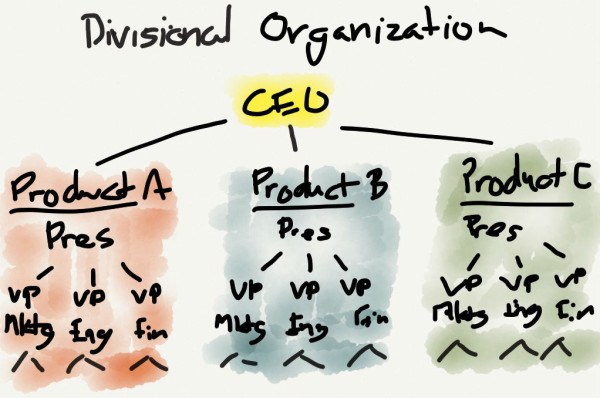
A divisional organization is organized by product.
In a divisional organization, different products are companies unto themselves. They have their own marketing, their own engineering,2 and their own finance. There may be some centralized functions, such as legal and HR, but but everything that makes money for a product lives within that product’s organization.
Most crucially, each product has its own profit-and-loss statement (P&L). The performance of each division is thus clear to everyone from the CEO to the division presidents to Wall Street, and accountability is usually directly tied to the P&L. So is motivation: senior division leaders have much of their income tied to the performance of their division.
This model scales to a very high number of products. Consider General Electric, the classic example of a divisional company. It has twenty-five different businesses, ranging from finance to jet turbines. The competitive advantage of such companies is usually in their management acumen and capital reserves, and the preferred employee is a generalist, able to quickly master any job with a refined set of skills.
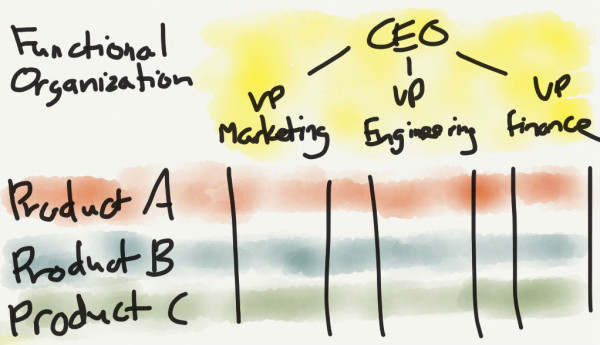
A functional organization is organized by function. Products are matrixed.
Functional organizations are the exact opposite: each function is siloed, and products cut across functions in a matrix-like fashion. This significantly expands the role of the CEO and his leadership team in all products, as that is the main point of coordination.
In this model, there is usually no ownership for a product’s P&L. Instead, everything accrues to the company’s all-up P&L, including compensation. In addition, the ideal employee is a specialist, not a generalist.
Most functional organizations are single-product companies; to put it another way, almost all companies start as functional organizations. In fact, the moment a company switches to divisions is as a good a marking point as any for the end of startup-hood.
Apple is the exception that proves the rule; they are functionally organized, but that absolutely does not mean a functional organization is best. Understanding why almost all corporations are organized by divisions (and how Apple manages a functional organization) illustrates why I think Ballmer is making a grave mistake.
Divisional organizations are better suited to multi-product companies
Microsoft has 13 distinct products and services with a run-rate of more than one billion dollars a year: Windows, Office, Xbox, SQL Server, System Center, Unified Communications, SharePoint, Developer Tools, Dynamics (ERP & CRM), Online display and search advertising, and Azure.
First off, that’s incredibly impressive and is one of Ballmer’s greatest accomplishments.
Second, look again at that list. There are certainly commonalities; for example, all of the products are built on software, just like DuPont, where gun powder and paint were both based on nitrocellulose. But the markets for Xbox and SharePoint, say, are totally different, again, just like they were for gunpowder and paint.
Multiple products in a functional organization are a recipe for a complete disconnect between functions, and Ballmer is putting at significant risk his greatest legacy: Microsoft’s diversification. Smaller, yet growing divisions will be hurt by this change.
Apple is the counterexample here; a central tenet tenant of management’s thinking is that Apple only ever have a small number of products. This isn’t just about design; Tim Cook is absolutely cognizant that a functional organization cannot effectively manage too many products.
Divisional organizations have built-in performance incentives
It’s easy to ignore talk about P&L’s and performance incentives, but the truth is few things are more critical to how organizations are run. People do what they are incentivized to do; it follows that employees who are compensated based on the performance of their division are particularly motivated to ensure the success of the product they work on.
Of course, compensation-based motivation is far inferior to mission-based motivation. For Microsoft, that mission used to be clear: “A computer on every desk and in every home, running Microsoft software.” Today, not so much. From Ballmer’s strategy memo:
Going forward, our strategy will focus on creating a family of devices and services for individuals and businesses that empower people around the globe at home, at work and on the go, for the activities they value most.
That’s so bland as to be meaningless, which means the impact on Microsoft’s shift to a functional organization are profound: what is going to motivate employees working on a huge array of products whose contributions are so far removed from the all-up P&L?
Again, the Apple counterexample: I wrote a few weeks ago that the latest Apple commercial – Designed in California – was written for Apple’s employees. This is why. Apple is uniquely reliant on non-monetary motivation; their employees genuinely believe they are making products that impact people’s lives. I doubt the same could be said for a random marketer on SQL Server.
Divisional organizations have built-in accountability
The flipside of motivation is accountability: the fact each product has its own P&L makes it very clear which division leaders are succeeding or failing.
Things are much less clear in a functional organization. To go back to the DuPont example, when the business was failing fingers were originally pointed at Sales. It was only when the vice-president of sales successfully demonstrated that they were doing nothing wrong that the company searched for another root cause.
Microsoft will face the exact same problem. Engineering will blame marketing who will blame finance who will blame engineering. This will absolutely be exacerbated by Microsoft’s internal culture, which steadfastly glosses over bad news and quietly ships out underperformers while throwing parties and praising their contributions.
This is something Apple is very clear about, stressing the idea of accountability without responsibility – you may be dependent on others, but if you fail, it’s your fault. Thus Rob Schoeben was fired for MobileMe, Mark Papermaster was fired for the iPhone 4 antenna, and Richard Williamson was fired for Maps. I have not seen any evidence of the same sort of ruthlessness at Microsoft recently, even with the clarity of divisional P&Ls.
Divisional organizations have clear career advancement opportunities for generalists
I’ve already noted that divisional organizations favor generalists; generalists also tend to favor divisional organizations as there is a much clearer career path. You are able to move up not only within a specific function, but you can also move laterally amongst divisions, usually with a nice jump in responsibility.
Microsoft has been hiring this type of person for years now: career-focused, monetarily-motivated generalists. In other words, the exact sort of person who does not do well in a functional organization that values expertise and experience.
I interned at Apple as an MBA student, and while I had a fantastic experience, it was well-known that MBA’s typically did not last long at Apple due to the limited options for career advancement and the fact you were only ever hired for what you did previously, not for the broader expansion of skills you supposedly picked up in school.
If Microsoft is truly committed to a functional organization they are likely going to face employee backlash, particularly on the business side.
Divisional organizations have competitive cultures; functional organizations need collaborative ones
Here I think we’ve finally arrived at the motivation for the switch.3 Cross-group collaboration at Microsoft is famously difficult:
However, if this is indeed the goal, reorganizing the company to improve collaboration is like burning down your house to kill termites. It ignores the root cause and a much more effective solution.
Last fall Kurt Eichenwald wrote a must-read piece about Microsoft’s lost decade. Every part of it was spot-on, particularly the section on employee reviews and stack ranking:
At the center of the cultural problems was a management system called “stack ranking.” Every current and former Microsoft employee I interviewed—every one—cited stack ranking as the most destructive process inside of Microsoft, something that drove out untold numbers of employees. The system—also referred to as “the performance model,” “the bell curve,” or just “the employee review”—has, with certain variations over the years, worked like this: every unit was forced to declare a certain percentage of employees as top performers, then good performers, then average, then below average, then poor.
“If you were on a team of 10 people, you walked in the first day knowing that, no matter how good everyone was, two people were going to get a great review, seven were going to get mediocre reviews, and one was going to get a terrible review,” said a former software developer. “It leads to employees focusing on competing with each other rather than competing with other companies.”
In my (very-biased) opinion, I believe collaboration is fundamentally broken at Microsoft. It is all about politics, not great outcomes, and that is absolute death in a functional organization, which has nothing but collaboration to hold together cross-functional product teams. At least in a divisional model all of the relevant team members have a common product and a common boss, meaning everyone has no choice but to work together. Unless the employee review and compensation model is significantly changed, this, along with the lack of mission and clear accountability, will grind progress to a halt.
I harbor no ill will towards Microsoft. They were a great employer and I loved my team, annual reviews notwithstanding. However, the impetus behind this move seems sadly characteristic of many of Microsoft’s initiatives – great on the surface, not so great in the details.
In this case, on the surface, functional organization are collaborative ones, and Microsoft needs to collaborate better. However, a closer examination as to why almost every organization of any significant size is divisionally organized suggests this may be Ballmer’s final folly.
- Most of the DuPont facts are drawn from Richard Tedlow’s excellent book, “Denial: Why Business Leaders Fail to Look Facts in the Face – And What to Do About It.”
- Or manufacturing, or whatever the primary function of the company is
- Although I’m not ready to dismiss pure Apple envy

